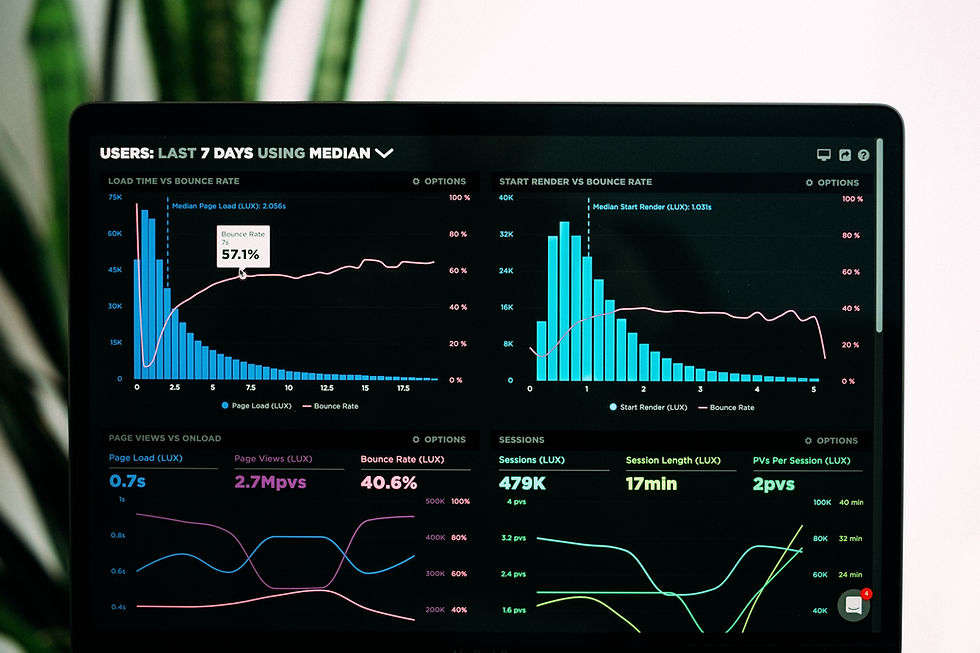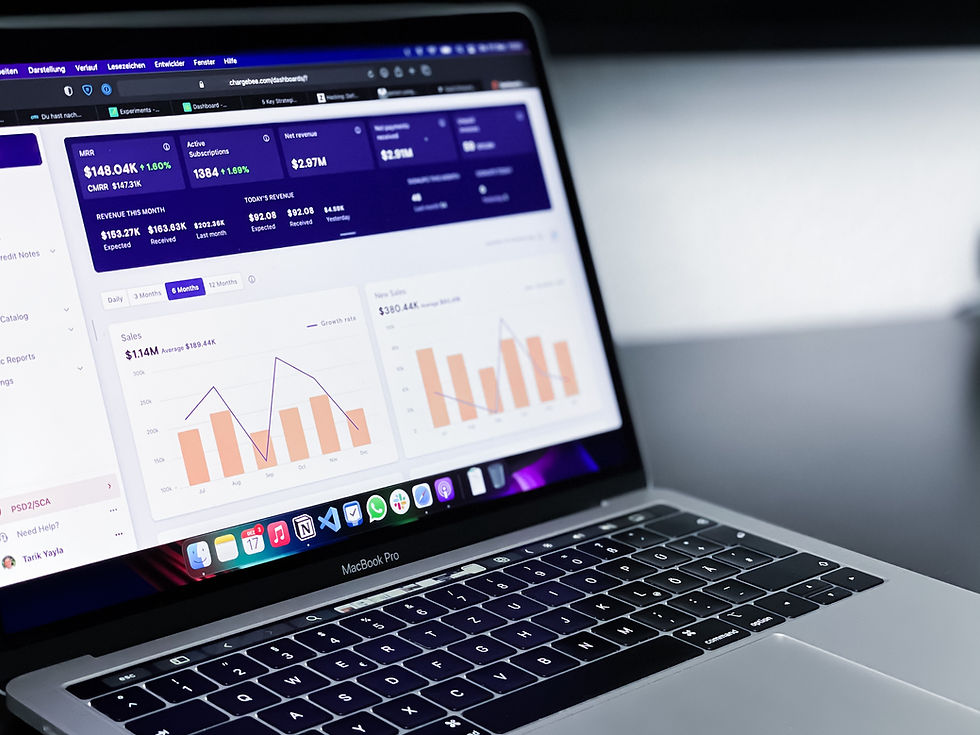Big Data Trends You Must Follow In 2023
- Kaylee Canning

- May 10, 2023
- 7 min read
Big data has revolutionized the way businesses, governments, and individuals process, store, and analyze information. With the explosion of data generated by the Internet of Things (IoT), social media, and other digital technologies, the field of big data is expected to continue to grow and evolve rapidly in the coming years. The future of big data is likely to be characterized by increased automation, artificial intelligence, and machine learning, as well as greater emphasis on data privacy and security.

Cloud-based storage and processing, edge computing, and real-time analytics are also expected to play a significant role in the future of big data. As organizations seek to extract valuable insights from the vast amounts of data available, the demand for skilled data scientists and analysts is also expected to continue to grow. Ultimately, the future of big data is likely to be shaped by a range of technological, social, and economic factors, as well as ongoing efforts to balance the potential benefits of data-driven insights with concerns about privacy, security, and ethical use.
Here are some examples of trends we may see in the future:
1. Increased adoption of edge computing and processing.
This refers to processing data closer to the source of its creation or consumption, rather than sending it all to a centralized server for processing. This approach can help reduce latency, improve data security and privacy, and reduce network bandwidth requirements. Edge computing is a distributed computing paradigm that involves processing data closer to the source, rather than sending it all to a centralized server for processing. By bringing computation closer to where data is being generated or consumed, edge computing can help reduce latency, improve data security and privacy, and reduce network bandwidth requirements. This can be especially important in applications such as the Internet of Things (IoT), where vast amounts of data are being generated by sensors and other devices in real-time.

The increased adoption of edge computing has significant implications for big data. Rather than relying on a centralized architecture, edge computing enables organizations to distribute their computing resources across a network of devices and infrastructure. This can help reduce the load on centralized servers, improve processing speeds, and increase the scalability and flexibility of big data applications. Edge computing also has the potential to enable new types of real-time analytics and machine learning applications, as well as support the development of more efficient and secure data processing workflows. As the amount of data generated by IoT devices and other sources continues to grow, the adoption of edge computing is likely to play an increasingly important role in the future of big data.
2. Growth in the use of artificial intelligence (AI) and machine learning (ML) technologies.
The growth of artificial intelligence (AI) and machine learning (ML) technologies has been one of the most significant trends in the world of big data in recent years. With the ability to automatically learn from data and make predictions based on that learning, these technologies have enabled businesses and organizations to extract valuable insights from the vast amounts of data that are now being generated every day. As AI and ML continue to evolve, they are likely to become even more powerful tools for processing and analyzing big data, enabling new types of applications and use cases.

The increasing use of AI and ML technologies is also driving the growth of big data itself. As more organizations seek to leverage these technologies to gain insights from their data, the volume, variety, and velocity of data being generated is likely to continue to increase. This, in turn, will create new challenges and opportunities for managing and processing big data, requiring new tools and techniques for storing, analyzing, and visualizing the data. As AI and ML continue to evolve, their impact on big data is likely to be profound, shaping the future of data-driven decision-making and enabling new forms of innovation and discovery.
3. Continued shift towards cloud-based data storage and processing.
The continued shift toward cloud-based data storage and processing is one of the major trends in big data, and it is likely to continue in the coming years. With the growing amount of data being generated by organizations, cloud-based data storage provides a flexible and cost-effective solution for managing and processing that data. Cloud-based storage allows organizations to easily scale their computing resources up or down, based on their business needs, and can help reduce costs associated with building and maintaining on-premise data centers.

This shift towards cloud-based storage also has significant implications for big data, as it enables organizations to process large volumes of data more quickly and efficiently. By using cloud-based tools for data storage and processing, organizations can quickly deploy new applications, run analytics on large datasets, and collaborate with others in real-time. This can help organizations gain new insights from their data, leading to better decision-making and improved business outcomes. As the demand for more efficient and scalable big data solutions continues to grow, the shift towards cloud-based storage is likely to play an increasingly important role in the future of big data.
4. Increased focus on data privacy and security.
In recent years, there has been an increased focus on data privacy and security as the amount of data being generated and stored has grown exponentially. The increasing frequency of data breaches and cyber-attacks have highlighted the need for robust security measures to protect sensitive information. Additionally, with new data privacy laws such as the EU's General Data Protection Regulation (GDPR) and California's Consumer Privacy Act (CCPA), organizations are now required to take greater care in how they collect, store, and use personal data. This has led to a growing emphasis on data privacy and security in the big data landscape.

The increased focus on data privacy and security has significant implications for big data. As organizations collect and process vast amounts of data, ensuring the privacy and security of that data has become a critical concern. To comply with data privacy regulations and protect sensitive information from cyber-attacks, organizations are investing in new technologies and processes for securing their data, such as encryption, access controls, and data masking. The focus on data privacy and security is also driving the development of new tools and techniques for anonymizing data, which can help protect personal privacy while still enabling the analysis of large datasets. As big data continues to grow in volume and complexity, the focus on data privacy and security is likely to remain a key concern for organizations, requiring ongoing investment in new security technologies and processes.
5. Greater emphasis on data governance and compliance.
Governments around the world are placing a greater emphasis on compliance with regulations related to data privacy, security, and ethical use. For example, in the United States, the Health Insurance Portability and Accountability Act (HIPAA) mandates strict rules for the handling of medical data, while the Federal Trade Commission (FTC) has issued guidelines for companies on how to handle consumer data. In Europe, the General Data Protection Regulation (GDPR) sets strict rules on how personal data is collected, processed, and stored, with significant fines for non-compliance. As governments continue to introduce new regulations and guidelines, organizations are under increasing pressure to ensure that they are in compliance.

The greater emphasis on government compliance has significant implications for big data. In order to comply with regulations related to data privacy, security, and ethical use, organizations must invest in new technologies, processes, and staff training. This may involve implementing new data governance policies, adopting stricter security measures, and ensuring that data is being collected and used in a manner that is ethical and transparent. Additionally, organizations must ensure that they are able to track and report on their compliance efforts, which may require new data management tools and processes. As the importance of government compliance continues to grow, it is likely to have a significant impact on the future of big data, driving the development of new technologies and processes that can help organizations comply with evolving regulations and guidelines.
6. Use of real-time analytics and streaming data processing.
Real-time analytics and streaming data processing are becoming increasingly important in the big data landscape. With the growing volume and velocity of data being generated, traditional batch processing methods are no longer sufficient to meet the demands of many organizations. Real-time analytics and streaming data processing allow organizations to analyze data as it is being generated, providing valuable insights and enabling timely decision-making. This can be particularly important in industries such as finance, healthcare, and e-commerce, where real-time insights can provide a competitive advantage.

The use of real-time analytics and streaming data processing has significant implications for big data. By processing data in real-time, organizations can identify and respond to trends and patterns as they emerge, rather than relying on historical data to inform decision-making. This can help organizations identify new opportunities, improve operational efficiency, and reduce risk. However, real-time analytics and streaming data processing also require specialized tools and expertise, and may require significant investment in new technology and infrastructure. As the demand for real-time insights continues to grow, the use of real-time analytics and streaming data processing is likely to become increasingly important in the future of big data.
Conclusion
In conclusion, the future of big data is constantly evolving and being shaped by a range of trends and developments. Some of the key trends that we discussed include the increased adoption of edge computing, the growth of AI and ML technologies, the continued shift toward cloud-based data, the increased focus on data privacy and security, and the greater emphasis on government compliance. These trends are having significant implications for big data, driving the development of new technologies, processes, and best practices.
As big data continues to grow in volume and complexity, organizations will need to continue to adapt and evolve in order to stay ahead of the curve and take advantage of the opportunities presented by this rapidly evolving landscape. Ultimately, the future of big data will be shaped by the ability of organizations to effectively collect, process, and analyze data in a manner that is secure, compliant, and ethical, while also providing valuable insights that drive innovation and growth.
At GenTech Marketing, we specialize in formulating digital strategies that maximize your return on ad spend and scale your revenue. Our team of experts has the experience and expertise to help you achieve your business goals. If you're ready to unlock the full potential of your business, we would love to hear from you.
Contact us today to learn more about how we can help you grow.




%20copy%202_edited_edited_edited.png)
Comments